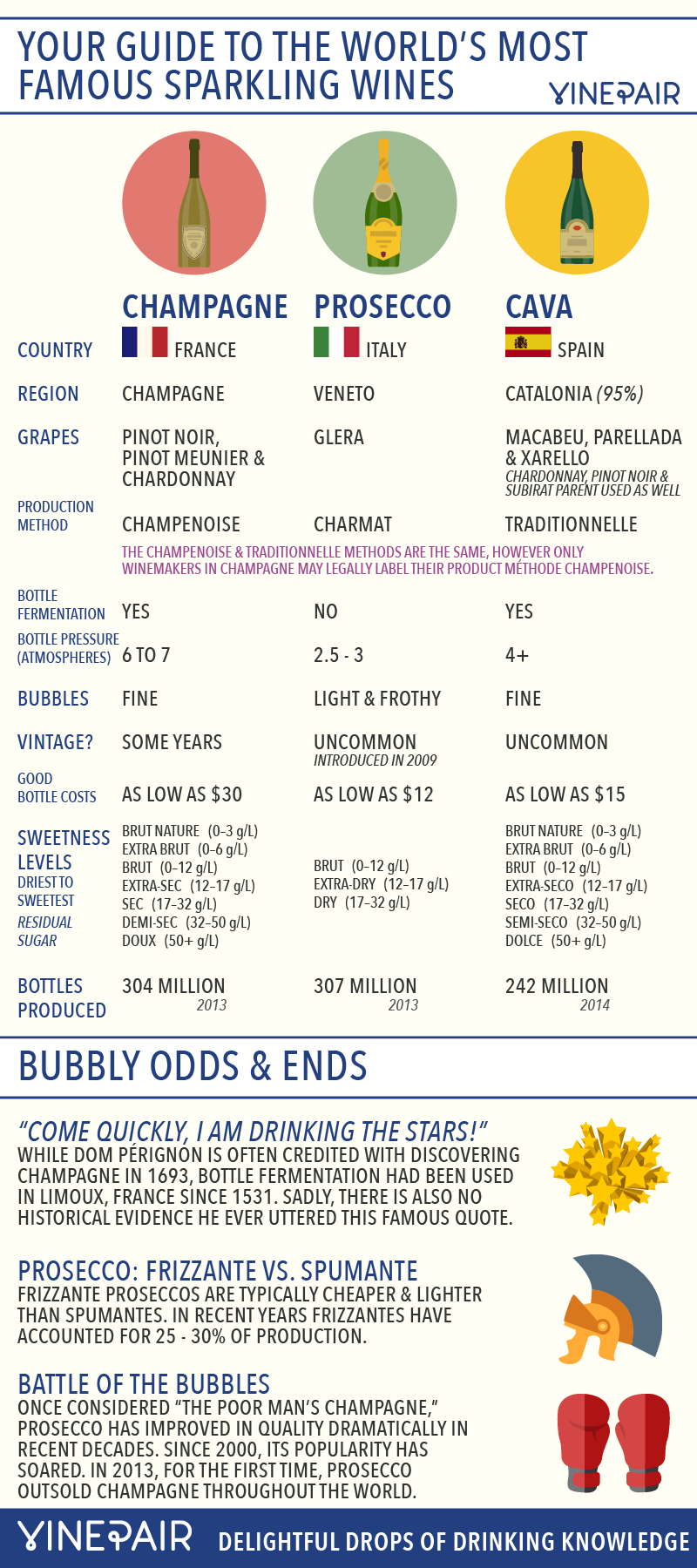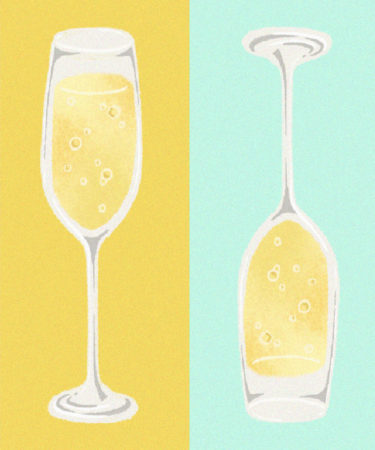Comparing Champagne and Prosecco is a natural thing to do. They’re both justifiably crushable and equally worthy of being opened to cheer a milestone, anniversary, or celebrate a promotion at work. In truth, aside from the fact that both are filled with nose-tickling bubbles, Champagne and Prosecco are very different.
From origins and grapes, to production methods and prices, Champagne and Prosecco have their own stories to tell. When it comes down to standing in the wine shop deciding which one to buy, it’s your taste buds, and perhaps wallet, that steer the decision making.
Champagne is French, Prosecco is Italian
While no two snowflakes are alike, certain conditions are necessary for all snowflakes to form. Sparkling wine is the same. Each kind is unique, but the climate conditions necessary to grow good-quality sparkling wine grapes are pretty similar.
The Champagne region in northern France and the Veneto and Friuli regions in northern Italy are both famously quite steep with hilly terrain. Vineyards on hillsides get more direct sunshine and heat, which is important, considering both regions are rainy and cool. These lower temperatures are also influential when it comes to acidity levels. Grapes used for sparkling wine need high levels of acidity, and are often picked early to avoid over-ripening.
Champagne Grapes vs. Prosecco Grapes
Champagne’s identity is shaped by a famous trio of grapes: Chardonnay, Pinot Noir, and Pinot Meunier. Most brut Champagnes are an equal mix of all three. Other styles include blanc de noirs, a white Champagne made from the region’s permitted black grapes, and blanc de blancs, a white Champagne made from only white grapes. There’s also rosé Champagne, which uses the same red grape varieties but with macerated skin contact to create some color. Alternatively, producers can blend still red wine with a still base white wine.
Prosecco is characterized by one grape, a highly aromatic white variety called Glera. Most producers try to make Prosecco using only the native grape, but if there’s a difficult growing season, then DOC and DOCG rules do allow blending. Up to 15 percent of such blends can be made up of other varieties such as Chardonnay, Pinot Bianco, Pinot Grigio, or white Pinot Noir.
Method Champenoise and Charmat Method
This is where things get a little sciency: We’re talking yeast and fermentation. When it comes to sparkling wine, méthode Champenoise and the Charmat method are integral to Champagne and Prosecco’s individualistic flavors.
Champagne is made using méthode Champenoise, or traditional method as it’s called if used outside the Champagne region. This method means the secondary fermentation (which is necessary to create the fizz) happens inside the bottle. This second fermentation is fueled by additional sugar (called dosage) and characterized by extended contact with the lees (yeast cells). This process requires hundreds of hours of manual labor and years of aging before bottles can be released. Thus, Champagne’s higher price point on store shelves.
For the Charmat method, or tank method as it’s sometimes called, secondary fermentation takes place within a giant steel tank. Without lees contact and bottle aging, the Glera’s green apple and peach aromatics and fresh character are preserved. This is why Prosecco is often described as light and fruity. The Charmat method is quicker and more affordable than the traditional method, resulting in a much more affordable bottle of bubbly.
Fizzy, Bubbly, and Effervescent
Think all bubbles are created equal? Think again. There are lively ones, fine ones, and even ones that are considered “aggressive.” When it comes to what separates Prosecco bubbles from Champagne bubbles, the difference lies in their level of pressure.
The most common kind of Prosecco is spumante, which has over 3 bars of atmospheric pressure. Frizzante is a lighter version of Prosecco, with less persistent bubbles that measure between 1 and 2.5 bars of atmospheric pressure. Champagne has the highest atmospheric pressure measuring at 5 or 6 bars.
Sweetness Levels of Prosecco and Champagne
Both Prosecco and Champagne follow the same scale when measuring sweetness (although with slightly different terminologies). Generally, the light and fruity character of Prosecco makes it seem sweeter than it is. For the most part, the gradient goes from brut (the most popular) to extra dry and Dry (which is, paradoxically, the sweetest). The most common level of sweetness for Champagne is also brut. However, the flavors that come from lees aging (brioche, almond, etc.) make it seem drier than Prosecco. Other levels are brut nature and extra brut, which are drier than brut and extra sec, sec, demi-sec, and doux.
How Prosecco and Champagne Taste
The flavor differences between Champagne and Prosecco are accentuated by contrasting winemaking methods and, of course, sweetness. Champagne will always have more yeast-derived character, with nutty aromas and toasty flavors. Prosecco, on the other hand, has less lees exposure with more emphasis on fruit and aromatic character.
Prosecco and Champagne in Cocktails
When it comes down to commonalities, namely their fizz, Prosecco and Champagne can be used interchangeably when mixing most cocktails. There are few hard and fast rules, other than ones dictated by your bank account, as to which is better. Given that an entry-level Champagne is roughly three times as much as a bottle of Prosecco, that can weigh heavily if all you’re going to do is mix it with orange juice.
What About Cava?
Cava is often referred to as the Champagne of France. It has that same lovely bubbly as its French counterpart that puts it into the sparkling wine category, but has a price point that’s much more affordable. Most Cavas originate from the Penedès region in Spain and are made using the “Traditional Method,” also known as the “Champagne Method.”

